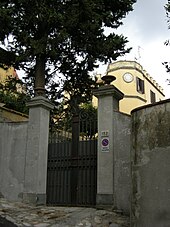
Samuel Langhorne Clemens, known by the pen name Mark Twain, was an American writer, humorist, essayist, entrepreneur, publisher, and lecturer. He was praised as the "greatest humorist the United States has produced", and William Faulkner called him "the father of American literature". His novels include The Adventures of Tom Sawyer (1876) and its sequel, Adventures of Huckleberry Finn (1884), with the latter often called the "Great American Novel". Twain also wrote A Connecticut Yankee in King Arthur's Court (1889) and Pudd'nhead Wilson (1894), and co-wrote The Gilded Age: A Tale of Today (1873) with Charles Dudley Warner.

Grand Duchess Maria Alexandrovna of Russia was the fifth child and only surviving daughter of Alexander II of Russia and Marie of Hesse and by Rhine; she was Duchess of Edinburgh and later Duchess of Saxe-Coburg and Gotha as the wife of Alfred, Duke of Saxe-Coburg and Gotha. She was the younger sister of Alexander III of Russia and the paternal aunt of Russia's last emperor, Nicholas II.

Ca' Rezzonico is a palazzo and art museum on the Grand Canal in the Dorsoduro sestiere of Venice, Italy. It is a particularly notable example of the 18th century Venetian baroque and rococo architecture and interior decoration, and displays paintings by the leading Venetian painters of the period, including Francesco Guardi and Giambattista Tiepolo. It is a public museum dedicated to 18th-century Venice and one of the 11 venues managed by the Fondazione Musei Civici di Venezia.

Villa del Poggio Imperiale is a predominantly neoclassical former grand ducal villa in Arcetri, just to the south of Florence in Tuscany, Central Italy. Beginning as a villa of the Baroncelli of Florence, it was seized by the Medici, became the home of a homicidal and unfaithful husband, and a lavish retreat for a Grand Duchess with imperial pretensions. Later given to Napoleon's sister, it was reclaimed by the hereditary rulers of Tuscany before being finally converted to a prestigious girls' school. During its long history, it has often been at the centre of Italy's turbulent history, and has been rebuilt and redesigned many times.
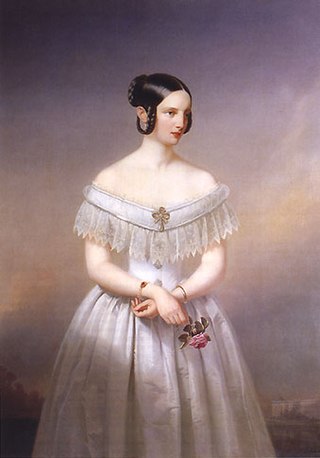
Grand Duchess Alexandra Nikolaevna of Russia was the youngest daughter and fourth child of Tsar Nicholas I, Emperor of Russia, and his wife, Princess Charlotte of Prussia. She was a younger sister of Tsar Alexander II of Russia.
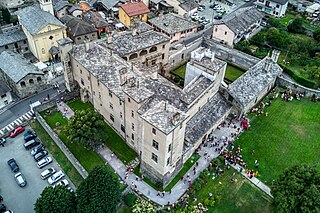
Issogne Castle is a castle in Issogne, in lower Aosta Valley, in northwestern Italy. It is one of the most famous manors of the region, and is located on the right bank of the Dora Baltea at the centre of the inhabited area of Issogne. As a seigniorial residence of the Renaissance, the Castle has quite a different look from that of the austere Verrès Castle, which is located in Verrès, on the opposite bank of the river.

Grand Duchess Maria Nikolaevna of Russia was a daughter of Emperor Nicholas I of Russia, and sister of Alexander II. In 1839 she married Maximilian, Duke of Leuchtenberg. She was an art collector and President of the Imperial Academy of Arts in Saint Petersburg.
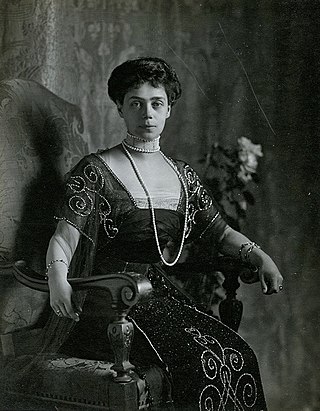
Grand Duchess Xenia Alexandrovna of Russia was the elder daughter and fourth child of Tsar Alexander III of Russia and Empress Maria Feodorovna of Russia and the sister of Emperor Nicholas II.

The Palazzo Mancini is a palazzo in Rome, Italy. From 1737 to 1793 it was the second home of the French Academy in Rome. It is located on Via del Corso, about a block north of Piazza Venezia.

Olivia Susan Clemens was the second child and eldest daughter of Samuel Clemens, who wrote under the pen name Mark Twain, and his wife Olivia Langdon Clemens. She inspired some of her father's works, at 13 wrote her own biography of him, which he later published in his autobiography, and acted as a literary critic. Her father was heartbroken when she died of spinal meningitis at age 24.

Count Pavel Pavlovich Demidov, 2nd Prince of San Donato was a Russian industrialist, jurist, philanthropist and nobleman of the House of Demidov. He was the only child of Finnish philanthropist Aurora Karamzin and Prince Pavel Nikolaievich Demidov.
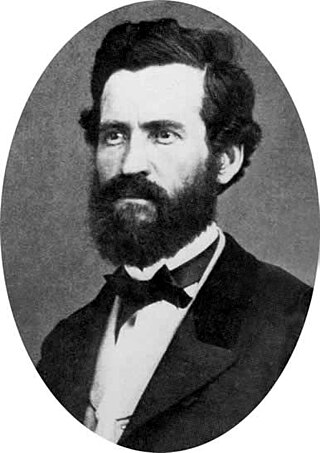
Orion Clemens was the first and only Secretary of the Nevada Territory. His younger brother Samuel Langhorne Clemens became a famous author under the pen name Mark Twain.

Duke Constantine Frederick Peter of Oldenburg was a son of Duke Peter Georgievich of Oldenburg and his wife Princess Therese of Nassau-Weilburg Known in the court of Emperor Nicholas II as Prince Constantine Petrovich Oldenburgsky, he was the father of the Russian Counts and Countesses von Zarnekau.
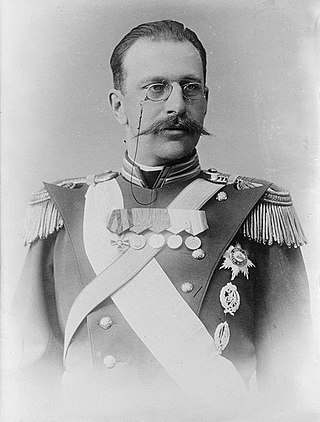
Duke Georg Alexander of Mecklenburg-Strelitz was the eldest of the two surviving sons of Duke Georg August of Mecklenburg-Strelitz and of Grand Duchess Catherine Mikhailovna of Russia. He was a great-grandson of Emperor Paul and a cousin of Emperor Alexander III of Russia. Although he was a German prince of the House of Mecklenburg-Strelitz, he was raised in Imperial Russia, where he lived all his life.

Stormfield was the mansion built in Redding, Connecticut for author Samuel Clemens, best known as Mark Twain, who lived there from 1908 until his death in 1910. He derived the property's name from the short story "Extract from Captain Stormfield's Visit to Heaven". The building was destroyed in a 1923 fire.

The Palacio de La Moncloa before the Spanish Civil War was the original Palacio de La Moncloa before it suffered damage during the Spanish Civil War and was rebuilt into the current palace with a very different layout from the original.

The Medici Villa of Poggio a Caiano, also called Ambra, is one of the most famous Medici villas and is located in Poggio a Caiano (Prato). Today it is state owned and it houses two museums: one of the historic apartments and the Museum of Still Life.
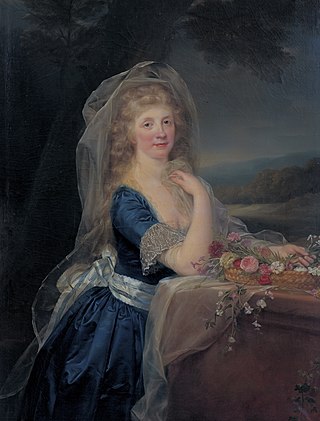
Anna Pieri Brignole-Sale (1765–1815) was a Sienese noble and court official. She was a supporter of the French Emperor Napoleon Bonaparte, and became a lady-in-waiting to his second wife, Marie Louise of Austria.
Olympia Bonaparte, Princess Napoléon, is the consort of Jean-Christophe, Prince Napoléon, the disputed head of the House of Bonaparte and, in the view of Bonapartists, the pretender to the abolished French imperial throne.

Villa Pliniana is a villa originally built in 1573, on the site of a more modest pre-existing building, in the territory of the municipality of Torno, in the province of Como, on the right bank of the western branch of Lake Como.


